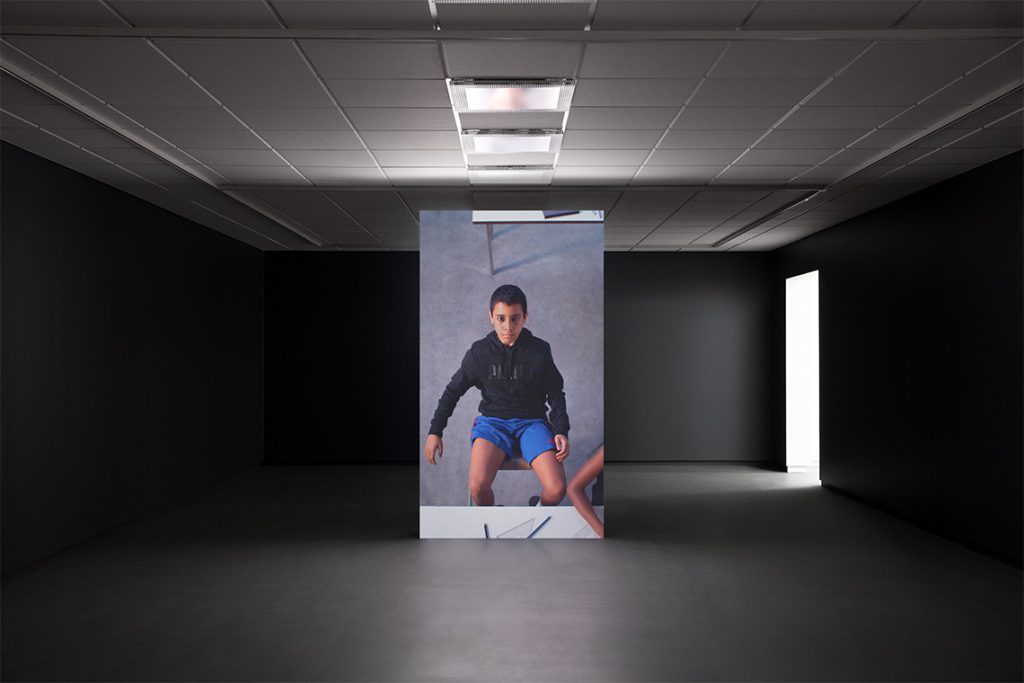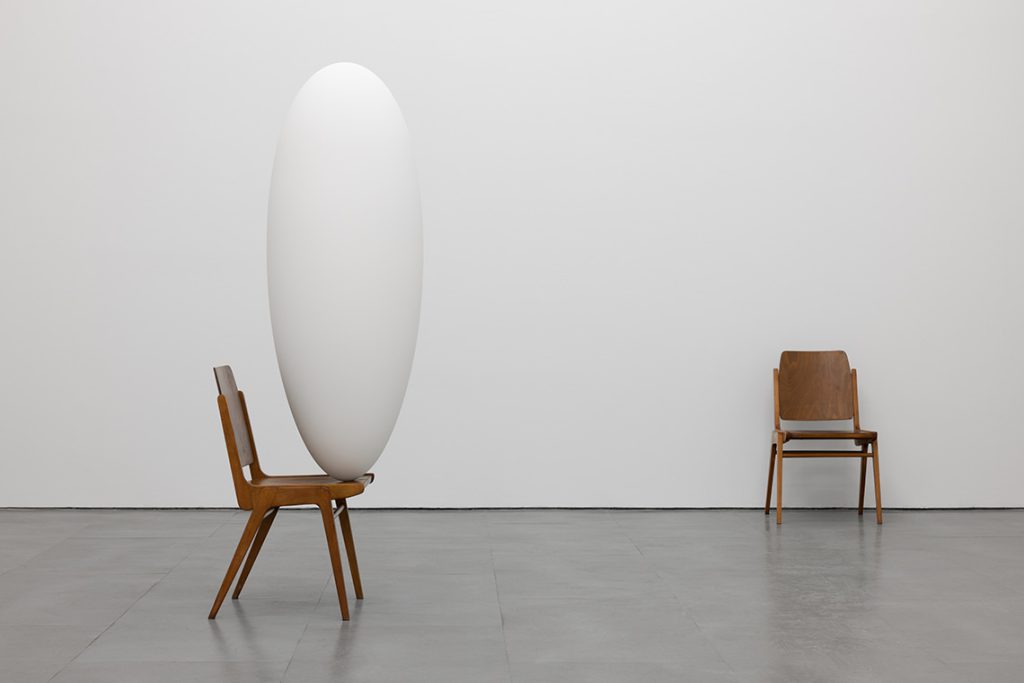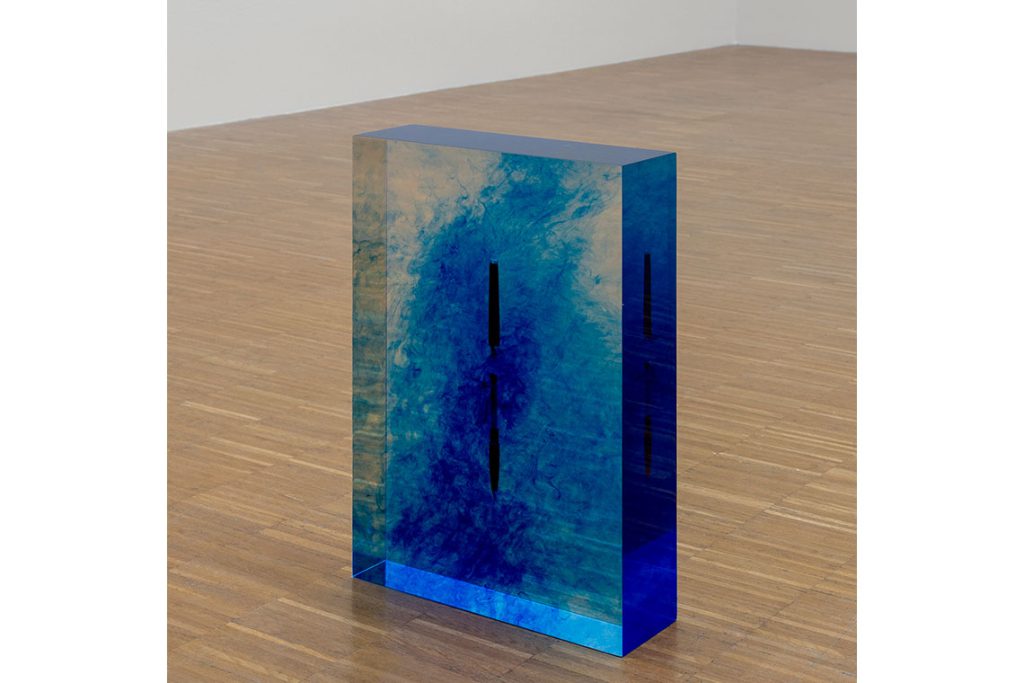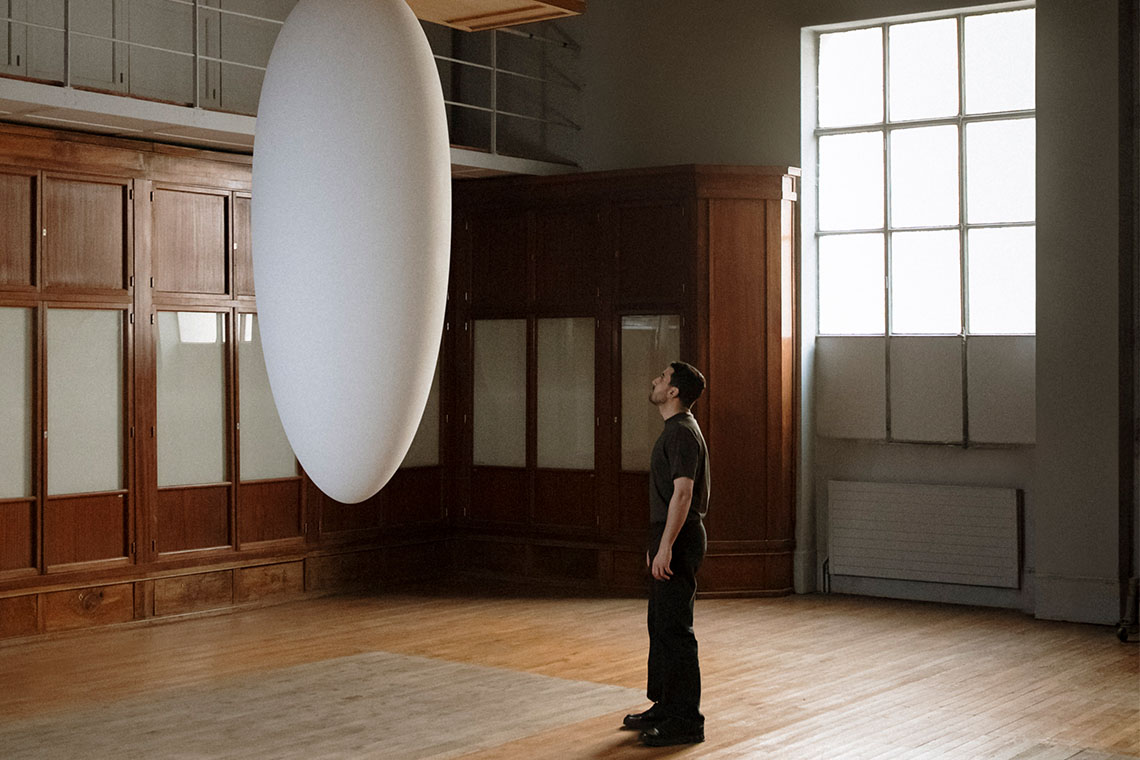The artist embodies the migrant experience through mysteriously constructed sculptures.
Levitation is an intrigue for Tarik Kiswanson. Journeying around geographies or plunging into lucid musings, a sense of hovering inhabits the artist’s sculptures, films, drawings and installations. “Levitation in my work exists as a metaphor for rootlessness,” he tells Canvas. “Works that look like they have lost gravity evince the uprooted condition of the immigrant, but within these works is also the possibility for movement and change.”
In the artist’s recent work in film and sculpture, weightlessness stands in for the body’s in-between existence. The home, a language, relatives and memories are the fleeting traits of the migratory drift. In Kiswanson’s visual vocabulary, a large egg-like sculpture suspended between two walls, or a shot of a child falling backwards, capture this sense of passage, as well as a new beginning. Departure is an act he approaches with an autobiographical lens as well: “Leaving a place behind, always being on the verge of moving somewhere, is a constant reminder of my own condition.”
Born to Palestinian parents in Sweden, Kiswanson settled in Paris 14 years ago. He maintains another studio in Berlin and, along the way, has also lived in London and New York. Fluent in five languages, he holds four different nationalities. During our FaceTime conversation at the tail end of January, he is on the other side of the Atlantic to install a mini survey exhibition at the Oakville Galleries art museum in Ontario. His North America stint is rather long, including New York for the French Ministry for Europe and Foreign Affairs Villa Albertine residency, which also takes him on research trips to California, North Carolina and Idaho. Shows in Madrid and Frankfurt later this spring will pull him back to Europe.

Image courtesy of the artist, Sfeir-Semler Gallery, Beirut/Hamburg and carlier | gebauer, Berlin/Madrid
The Marcel Duchamp Prize-laureate’s positioning between geographies is little different from the ellipse fibreglass and resin form in his sculpture, The Wait (2023). Sitting on the edge of a wooden chair, the smooth cocoon is neither perched nor released – Kiswanson is poised in his determination to exist between states. Another namesake sculpture includes the same silhouette in larger scale, modelled after the artist’s own physical measurements. The oval body is suspended between two walls and a vertical stainless steel folder cabinet, which carries a bureaucratic aloofness. The juxtaposition signals mortality and fragility, as well as metamorphosis.
A similar transitory slipperiness also lingers in the artist’s moving images. The Fall (2020) chronicles the eponymous act experienced by a boy releasing himself backwards on a chair. A seconds-long instance is stretched to a sequence of almost ten minutes in duration, the rapid release rendered in a painterly stillness. The Moroccan-Belgian boy whom Kiswanson street-cast lives in the suburbs of Brussels and can communicate in five languages – an avatar of the artist’s own childhood on the outskirts of Malmö, he embodies the duality of drift and immobility, belonging and detachment. Collaborations with adolescents in film and performance imbue the work with another level of transition as they move from childhood to teenage years. “We are very extroverted at those ages; we are curious about the world and we start to build an understanding of justice or class,” Kiswanson notes about this profound and formative period in life.

Image courtesy of the artist, Sfeir-Semler Gallery, Beirut/Hamburg and carlier | gebauer, Berlin/Madrid
Curiosity during his own upbringing perhaps led the way to a career which started in writing. Between Arabic at home and Swedish at school, Kiswanson found himself composing poetry at the age of 13. “I was trying to understand my existence in the world with incoherent words,” he recalls. Living in a building with Vietnamese, Bosnian, Afghani and Iraqi immigrant families provided what he calls today “a utopia of different cultures coexisting”, and he found solace in writing through a stream of consciousness. “I didn’t know it was called poetry,” he muses. The reason behind his organic transition from words to images “still feels inexplicable”, but he believes a realisation of what he perceives as the inadequacy of words was a factor. Communicating through different languages prompted a search for a visual language, and “the constellation of different works is like an alphabet: together they write discourse and change our relationship to time and space.” Traversing different media links to Kiswanson’s desire to explore the potential visual grammar of his works. “I am interested in the negative space, in what kind of ‘writing’ submerges in-between, by association,” he explains.
Unsurprisingly, the first physical artworks Kiswanson created were tied to absence and loss. He looked no further than the furniture his grandparents tried to haul from Palestine. Chairs and a wardrobe had followed them across North Africa on the way to Europe, and in the artist’s re-imagination, these were spectral bodies with copper and brass strips, welded together with melted silverware and wood. Family photographs and archives provided inspiration for his hollowed sculptures, as did “the collective struggles of those who had to make something out of post-exile trauma”. The unity of subjective experiences was at the core of the project he exhibited at Centre Pompidou last year for the 23rd Prix Marcel Duchamp exhibition. A sound piece, titled First Day (2023), featured the voice of his mother reciting her recollections of trying to learn Swedish and opening a bank account. Another cocoon sculpture, The Relief (R Gabriel, 1945) (2023), revisited the story of the architect René Gabriel, who was assigned by the French government to create furniture for those who had lost their belongings in the Second World War. Chairs, drawers and wardrobes with rudimentary design cues resonate with “reconstruction and how the humanity is confronted with transformation after trauma,” the artist says.

Image courtesy of the artist, Sfeir-Semler Gallery, Beirut/Hamburg and carlier | gebauer, Berlin/Madrid
The Villa Albertine residency in New York will let Kiswanson delve deeper into furniture’s connection to personal histories marred by war and oppression. Similar to his family’s story of arriving in Scandinavia through Jordan, Turkey and Germany, the experiences of two historical furniture designers – George Nakashima and Thomas Day – are the subjects of his study into the human urge to create in the face of oppression and despair. The 19th-century cabinetmaker Day’s life in North Carolina as a Black designer and the 20th-century woodworker and architect Nakashima’s confinement in an internment camp with other Japanese-Americans during the Second World War are both helping the artist understand what comes out of the invasion of social politics into personal stories.
Research has always been the key to Kiswanson’s practice. However, he believes in the power of sifting the findings through the soul. “Research must be processed through the unconscious,” he says. Poetry still must cut through and free the work from gravity. “What is born from within is much more important. I also rely on my hands to guide me.” The alchemy of memory and history eventually yields the tangible – one that holds the potential to levitate.



